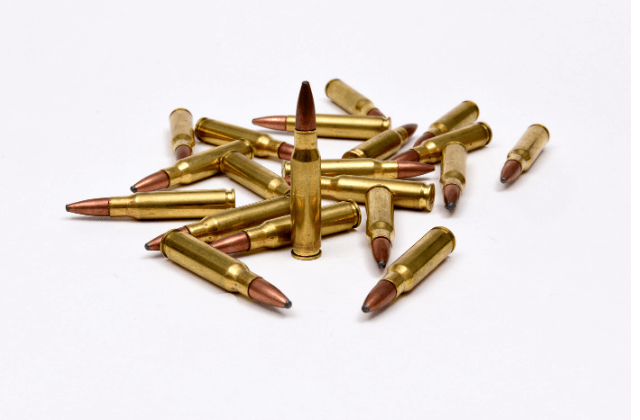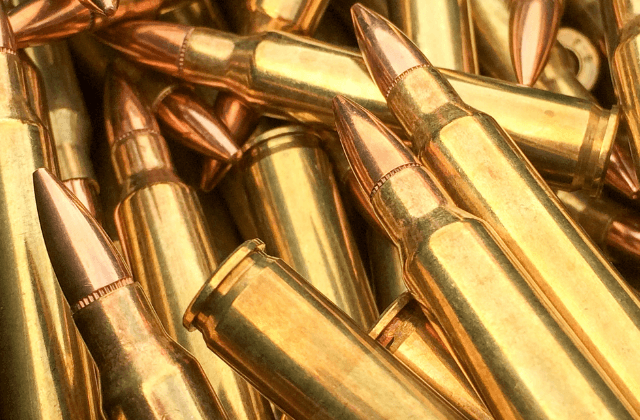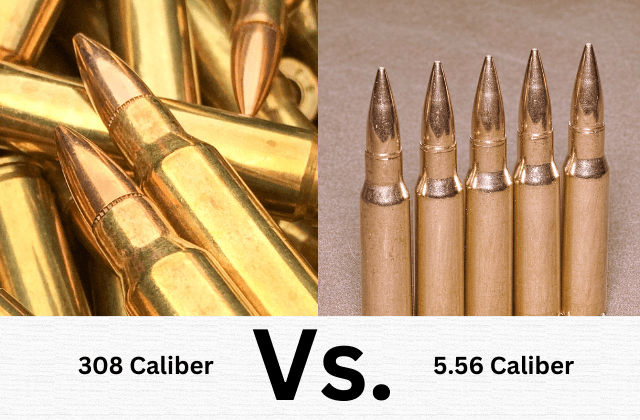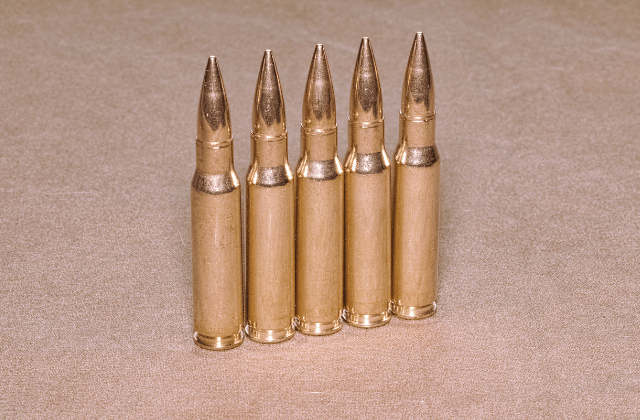This site contains affiliate links. As an Amazon Associate, I earn a commission from qualifying purchases at no extra cost to you. Full Disclosure Here.
Both .308 Winchester and 5.56 NATO have similar decorated military histories, not to mention incredible civilian popularity.
.308 is associated with the slightly older AR-10, while 5.56 is famous for being the primary chambering of the venerable AR-15.
But with both rounds having huge fanbases and impressive histories, how do you know which round is best for you? Well, that’s what we’re here for!
In this guide, we’ll review everything you need to know about .308 vs. 5.56. We’ll look at each round in turn, then go over the most important factors, making a direct comparison.
308 vs. 5.56 Comparison Table
Let’s start with a side-by-side comparison of the basic stats for these two different rounds:
| .308 Winchester (165gr) | 5.56 NATO (55gr) | ||
|---|---|---|---|
| Most Common Bullet Weights | 150gr, 165gr, and 180gr | 55gr and 62gr | |
| Effective Range | Up to 1,000 yards | Up to 500 yards | |
| Velocity (fps) | Muzzle | 2700 | 3130 |
| 100 Yards | 2440 | 2740 | |
| 200 Yards | 2194 | 2382 | |
| 300 Yards | 1963 | 2051 | |
| 400 Yards | 1748 | 1750 | |
| Energy (ft-lbs) | Muzzle | 2670 | 1196 |
| 100 Yards | 2180 | 917 | |
| 200 Yards | 1763 | 693 | |
| 300 Yards | 1411 | 514 | |
| 400 Yards | 1199 | 372 | |
| Trajectory (in.) | 100 Yards | 2.5 | 1.1 |
| 200 Yards | 0 | 0 | |
| 300 Yards | -9.7 | -7.3 | |
| 400 Yards | -28.5 | -23 | |
| Recoil | Energy (ft-lbs) | 18.1 | 3.9 |
| Velocity (fps) | 12.5 | 6 |
308 Caliber – A Quick Review
Now let’s dig in a bit more, starting with .308.
.308 came into being shortly after the end of the Korean War when the US Armed Forces began looking for a more modern replacement for the M1 Garand as the military’s standard service rifle.

Developers took the round that the M1 Garand used, the .30-06 Springfield, AKA the 7.62x63mm NATO, and shrunk the length down, creating a round that had virtually identical ballistic performance but with a reduced weight and shorter length. This new round was designated 7.62×51 NATO and paired with the brand-new M14 rifle.
7.62×51 NATO and the M14 debuted in 1954. However, the M14 didn’t serve very long before being replaced. Still, 7.62 NATO was able to hold on through the use of various US military machine guns, but also through its introduction to the civilian market as .308 Winchester.
These days, a huge variety of .308 loads are available on the market, so it’s easy to find one optimized for your needs. Bullet weights are available from as low as 55gr all the way up to 180gr. However, the most common bullet weights are 150gr, 165gr, and 180gr.
These heavy bullets and powerful rounds allow for the main draw of .308: its stellar ballistic performance, even at extended ranges. It’s remarkably accurate with considerable stopping power and is effective at distances up to 1000 yards, depending on the particular load.
Like its .30-06 predecessor, the .308 Winchester is extremely popular (especially outside the US) for hunting medium to large game, particularly deer, elk, and moose, though it’s also recommended for bears. It’s also a very popular competition round, particularly for long-range competition.
However, .308 does come with the downside of pretty significant recoil, so it is fading in popularity for long-distance shooting in favor of softer recoiling rounds like 6.5 Creedmoor.
Check this article to know the full comparison between .308 vs .30-06 Caliber.
5.56 Caliber – A Quick Review
5.56x45mm NATO, along with its civilian version, .223 Remington, was developed starting in 1957 as a joint effort by the Remington Arms and Eugene Stoner at Armalite to meet goals set out by the U.S. Continental Army Command (CONARC) in order to find a replacement for the M14 and 7.62x51mm NATO.

The new .223 Remington cartridge was created by extending the case of the existing .222 Remington case, and the rifle designed to go with it, the AR-15, was a shrunken version of Stoner’s previous AR-10, which was chambered in 7.62x63mm NATO.
The new round and rifle showed great promise in initial trials, edging out the M14 and 7.62 in side-by-side comparisons, and was accepted by the Sporting Arms and Ammunition Manufacturer’s Institute (SAAMI) in 1962.
The US military officially adopted .223 Remington and, at the same time, began seeing outstanding success in the civilian market alongside the AR-15.
Then, in 1970, FN Herstal used .223 Remington as the foundation for developing a new, more powerful round. This variant on .223 Remington was quickly adopted by NATO members to be used alongside 7.62 NATO and was given the designation 5.56x45mm NATO.
.223 Remington and 5.56 NATO are nearly identical, even down to the dimensions of the case. Where the difference lies is in the higher maximum pressure of 5.56mm, 61,000 PSI, compared to 55,000 PSI.
This pressure difference means that although they can be chambered in the same weapons, .223 Remington and 5.56 NATO are not interchangeable. Any rifle that shoots 5.56 can also shoot .223 Remington, but rifles designed for .223 specs only may not be able to tolerate 5.56, and trying to shoot 5.56 in these rifles can lead to dangerous, catastrophic failure.
Civilians mostly go for .223 Remington anyway, leaving 5.56 for the professionals, but both are available in civilian markets. In addition, many AR-15s, and .223 Remington rifles in general, are built for 5.56 NATO just to be safe.
Visit this article to know more about 5.56 vs. 300 Blackout.
308 vs. 5.56 – Major Similarities and Differences
Now, let’s take a look at how these two rounds compare when it comes to a few major factors.

Recoil
First things first, 5.56 is the clear winner when it comes to recoil.
.308 has a much heavier bullet and a much larger case capacity, so it has considerable recoil compared to the more petite 5.56, making 5.56 easier to fire accurately and with quicker follow-up shots.
Penetration
Penetration is one of the primary disadvantages of .223 and though the extra oomph of 5.56 helps fix this problem, it still doesn’t measure up to .308. The lighter bullet of 5.56 is much more prone to tumbling or deflecting when it hits a barrier.
On the other hand, overpenetration is a concern for .308, so that’s definitely something to keep in mind if you’re thinking about home defense. If you live in an apartment or otherwise close to neighbors, .308 has the potential to go straight through a wall, potentially harming bystanders.
Weight
The largest contributor to a round’s overall weight is its bullet weight. Since we’ve already established that .308 has a significantly heavier bullet (about three times heavier, in fact, depending on the exact bullets) than 5.56 does, it, therefore, comes as no surprise that complete rounds of .308 ammunition are far heavier than 5.56 rounds.
In fact, a loadout of 5.56 ammo will contain almost 2.5 times as many rounds as a loadout of .308 of equal weight.
With that said, most of us aren’t carrying hundreds of rounds of ammo with us, and weight is not a factor for home defense. On the other hand, the extra weight is worth keeping in mind if you have a significant trek out into the bush to get to your favorite hunting location.
Stopping Power
.308 dwarfs 5.56 when it comes to energy and therefore stopping power, especially at longer ranges. In fact, a 165-grain .308 round has more energy at 400 yards than a 55-grain 5.56 round does out of the muzzle, and at 400 yards, the .308 still has 1199 ft-lbs of energy.
It’s not even close, and that extra stopping power is why .308 is capable of dealing with larger game much more effectively than 5.56.
Accuracy
Accuracy is a bit more complicated.

The heavier bullet of .308 Winchester means it will suffer from bullet drop more than its 5.56 NATO cousin. On the other hand, it also means that it’s less prone to wind drift.
Ultimately, you’re unlikely to notice much difference in performance within about 500 yards.
Speaking of which…
Effective Range
When it comes to range, .308 is the winner without question.
5.56 NATO has an effective range that caps out at around 500 yards. .308, however, is effective at ranges up to twice that. Long-distance shooting is, after all, what .308 rifles was designed for, and it’s a favorite among military and LEO snipers for a reason.
Availability
Fortunately, both .308 and 5.56 are widely available in a vast variety of different ammunition options. You should be able to find several types of each of these rounds just about anywhere you can buy ammo. If you’re shopping online, your options are virtually unlimited.
And to make things even better, pricing is generally pretty great relative to other rounds as well. You should expect to spend more on .308 than 5.56, but not by a ton.
Reloading
Just like there are tons of options for buying complete factory rounds, there are also plenty of options for reloaders, so if you want to build your own ammo, both of these rounds are great options. With so many choices available for both cases and bullets, you can load and experiment to your heart’s content.
Hunting
Either .308 or 5.56 can be a great round, but they’re best suited for different situations. As we just established, if you want to be able to make long-range shots, you’ll need to go with .308. Similarly, if you want to shoot game larger than a deer, you’ll need the extra stopping power that .308 provides.
However, for shots within 500 yards or for hunting small to medium-sized game, 5.56 is perfectly well-suited, maybe even better than .308, thanks to the reduced bullet drop.
Home Defense
For home defense, I definitely suggest going with 5.56 over .308. In a home defense situation, you won’t need the extra range or stopping power of 5.56, so it only creates an additional risk of over-penetration. Avoid the risk and just go with 5.56.
FAQs
.308 Winchester and 7.62x51mm NATO are similar but not completely identical cartridges. The dimensions of the two cartridges are the same, but 7.62 NATO is loaded to higher pressures than .308 Win. Both can be used in the same rifles.
Yes, .308 Winchester is generally considered a high-power round. There is no single definition for what constitutes a high-power round, but generally, the various .30 caliber rounds are included. That includes not just .308 Win and 7.62x51mm NATO but also rounds like .30-06, 7.62x39mm, and 7.62x54mmR.
.223 Remington is nearly identical to 5.56 NATO and the two rounds will generally operate interchangeably in the same rifles. However, 5.56 NATO is a higher-pressure round, and some .223 Remington firearms are not designed to withstand that pressure. Always check the specs for your gun before attempting to fire an alternate caliber.
Conclusion
Ultimately, when it comes to .308 vs 5.56, you can’t really say one is better than the other. The rounds each have their own advantages and disadvantages, so they’re better for different purposes.
If you need an effective round for inside 500 yards and/or are hunting small- to medium-sized game, 5.56 is the round for you. On the other hand, if you need a longer range round and/or are hunting big game, you need the extra power of .308. Both are easy to find in stores, but 5.56 NATO does come at a lower cost.
So, since there’s no right or wrong answer, just go with the option that best suits your needs.

